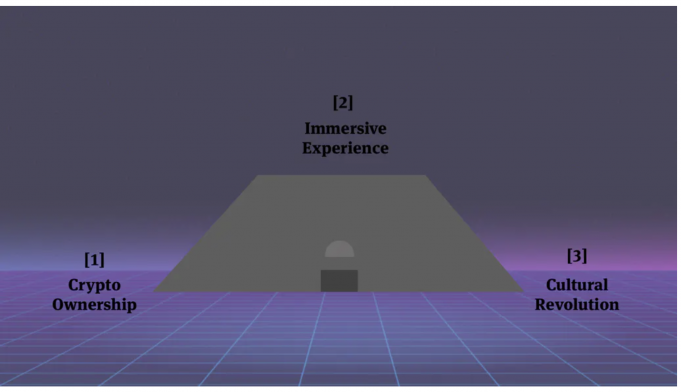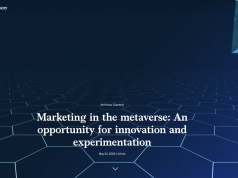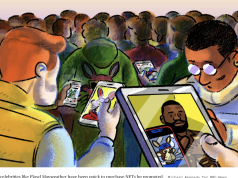Sam Lessing, The Information November 12, 2021
After a good 15-ish–year run, most technology watchers agree that we are nearing the end of Web 2.0, and that the dawn of Web 3.0—aka the metaverse, depending on whose positioning you prefer—is upon us.
This transition is taking place against a complicated backdrop featuring no fewer than three simultaneously developing but fundamentally distinct trends:
- First is the rise of crypto, which is leveraging technical and economic breakthroughs to make it finally possible to put memory, assets and ownership natively on the web.
- Second is the seeming imminence of the experiential web via augmented and virtual reality. As many see it, this set of technologies will have a profound effect on our relationship with digital spaces and communities.
- Last is a cultural revolution—long brewing among the younger generations but accelerated and disseminated by the Covid-19 pandemic, which forced great swaths of people to work and socialize in purely digital spaces. People are now rapidly coming to value their digital lives, communities and spaces every bit as much as their physical ones.
Things didn’t have to play out this way—that is to say, none of these trends is the direct result of any of the others—yet here we are. Let’s use this moment to take stock.THE TAKEAWAY
The metaverse isn’t one thing—it’s the intersection of three distinct and parallel revolutions. By now it’s clear we’ll move from one universe to many, but it’s far too early to tell how these worlds will interact.
What Seems Certain
1) We’ll have peer universes.
We have all lived through a somewhat anomalous period in world history where, by and large, most people have shared the same global reality. We participate in a fully integrated global economy. We can travel anywhere on earth in a matter of hours and, via the internet, talk to almost anyone almost instantly and for free. In effect, we all live in one room.
There seems to be no question that we’re going back toward fragmentation. This is already happening without the need for VR and AR, crypto, and so forth, as people sink deeper into narrowly defined, often technology-enabled social cults. In a sense, the future will look something like the past, but instead of communities being geographically bound, they’ll be bound by ideology and culture.
The negatives to this are obvious and concerning—the splintering of society, deep intranational social and cultural divides, mistrust of authority, and on and on. However, on the positive side, right-sizing our communities down to a more human scale will almost certainly help reestablish the sense of place that the globalized internet destroyed for so many of us.
2) There will no longer be just one economy.
This is hard to conceptualize for those of us that have grown up in a single, dollarized financial system where everyone values, trades, accounts and denominates in basically the same way. But the most important thing crypto gives us is the ability for communities to compose their own economies on the fly, backed by differentiated actions and forms of value.
This could be a force for good. For example, as we’re all now painfully aware, our mono-economy doesn’t work very well for something like decarbonization, the ultimate tragedy of the commons. On the other hand, it’s possible to envision how, using the crypto toolkit, a community could come together to invent and drive an alternative financial system based on carbon removal. The tools are all there.
Make no mistake, the Bitcoiners, the Sol army, the Dog-meme-coin cults, the NFT punks should all be taken seriously in the short term, but they’re just the tip of the iceberg in terms of what we’ll see in the just slightly longer term. Distinct communities become much more powerful when they can create their own full-fledged digital economies—and the two reinforce each other.
3) Many, if not most, people will spend more time inhabiting digital spaces than they will physical spaces.
If you’re reading this, you have likely worked hard and gotten lucky in the human life lottery. For you, the physical world is likely pretty good. That puts you in the minority of global citizens.
As digital experiences get more complete, those people for whom the physical world is less sweet will retreat deeper into their individual virtual universes. In a sense, the physical world will become just another parallel and peer world some people inhabit—not something different or special, just the original world.
Please withhold judgment. This development won’t necessarily be either bad or good, but rather the natural course of events as people seek out spaces where their abilities and contributions are valued. In a real world of 7 billion–plus voices, it’s hard for anyone to get this recognition. When the natural physical boundaries that have protected human communities disappear, this is the next logical direction.
4) The various facets of the metaverse will evolve in parallel.
Historically, new platforms evolve sequentially: First someone creates a new set of technical capabilities—a mobile phone, a gaming world, a social network; then communities and assets are formed on top of them.
That is not how things will play out this time.
Large and powerful digital cults are already forming. Non-fungible tokens and all sorts of digital assets are being created and traded on crypto platforms and beyond. Any 3D digital communities that exist today will have to be ported into new virtual spaces as they develop. Each new technology will no doubt be an upgrade, but it won’t necessarily be terra nova.
5) We will have a tiny number of companies but a huge number of creators.
The thing about the experiential side of the metaverse is that it’s going to be beyond insanely expensive to build and host, which is why it’s the type of investment only companies at Meta’s scale can even dream of taking on. On the other hand, with the open tools of crypto, community and economy building will be an open playing field.
This will engender some complicated power dynamics. If the last generation of platforms were so powerful that platform owners had implicit control over their users, with this iteration I think it’s possible—even likely—the flow of power will go the other direction.
In a world where the experience of technology dominates user demand, communities have to conform to platforms. But in a world where the communities are portable, the platforms will be forced to woo the communities and match their demands.
What We Still Need Answers To
1) Will we have a metaverse or a multiverse?
Setting aside the fun tip of the hat to Neal Stephenson, the subtle but important distinction is this: A metaverse is a container or host of many ’verses. A multiverse, on the other hand, you can think about as many distinct interconnected ’verses with no container at all.
My personal belief is that multiverse will be the more appropriate technical term. This comes from a crypto-first mindset, where we’re already seeing communities move between chains and experiences pretty seamlessly.
What I expect is that virtual communities will form initially on one platform (only because they have to form somewhere) but will likely exist in many different digital worlds at the same time. Members of the community will have tokens, NFTs and so on, which will serve as passports for whatever platform the community happens to meet up on or migrate to. In this context, even the physical world we know today will be another ’verse in the multiverse.
This platform-agnostic version of the future is pretty critical to make digital communities safe, sticky and trustworthy enough to form an important part of human experience. If you’re stuck on one platform and worried about getting kicked off, how much can you really trust the community?
If I’m wrong about all this, it will be because the experiential nature of one platform becomes so compelling that everyone effectively folds into that system. If that happens, then the future really will be metaverse versus multiverse.
2) How will new ’verses grow?
New worlds with nothing in them won’t go anywhere. Therefore, there are two possible ways to start.
The first is to make really good single-player versions of experiences. This pattern exists in gaming, of course, but it also exists in all sorts of Web 2.0 software. The second is to seed the world with people from another pre-existing experience, the way Facebook built on Harvard’s undergraduate email system to bootstrap a new experience from an existing network. (The more modern and commonplace version is to import contacts from cell phone address books.)
For metaverse experiences, what will be the equivalent? My bet is that it will come from pulling in existing groups from platforms like Facebook and crypto communities. As I mentioned earlier, I would highly expect a crypto-punk “island” to show up in many new ’verses. Over time, though, the real test of a metaverse platform will be whether it can create and sustain new communities and relationships.
3) How will trade work between ’verses?
One thing I don’t understand is how, if assets in the multiverse or metaverse are portable between ’verses, anyone will balance the economy of a given ’verse in a sensible way.
Currently the closest thing we have to a metaverse is the realm of massive multiplayer online games, ranging from World of Warcraft to Minecraft. Most of these monetize by selling in-game goods and tools. If you think of them each as a country, you could say they have carefully tuned economies that both keep the games fun for players and make the platform companies quite a bit of money.
Now imagine that you have a new country with no trade barriers, so anyone who wants to can move in, along with everything they own. How do you create and balance an economy in that situation? My sense is that you don’t, which means we’ll need protectionist policies to protect the experience within individual ’verses.
4) Can experience really be leveraged for profit?
Web 2.0 assigned value in a few key ways: to services, to content, and of course, to attention.
Crypto gives us a blueprint for assigning value in a metaverse-oriented Web 3.0: Those who mine or mint coins or tokens are rewarded; those who facilitate the exchange or trade of coins or tokens are rewarded; and those who contribute to the health growth and upkeep of the community are rewarded, too.
What’s still far from apparent is where the creation of new experiences fits into all this. I’m sure people will still be able to monetize using traditional Web 2.0 techniques. But will native Web 3.0 experiences actually make money on their own?
For the answer to be yes, experiential platforms will have to become the best places not just to explore and inhabit, but also to create new things of value. Think of it this way: Today’s digital assets are consumed on the web, but they’re produced in the Adobe suite. For an immersive experience to become the place where things are minted, it has to facilitate both production and consumption. While I’ve seen some compelling demos, this version of the future still seems to be a long way off.
5) Will creators finally make money in the metaverse?
I don’t know, but my fear is that, aside from a few very lucky superstars, they will not. It’s the simple reality of competition—if you get an immersive and frictionless digital environment going, there will inevitably be too many creators looking for work to sustain pricing. Unless or until creators form guilds, the likely outcome will just be a race to the bottom on pricing.
This is already happening in the creator and gaming economies. To be sure, more people are supporting themselves independently than has been the case historically. But in most cases, that means getting by marginally at best. It isn’t clear how that would be any different in the metaverse.
6) Will app stores exist?
Boy, I hope not. For the last tech generation, app stores were a choke hold exerted by platform owners on developers and users. If they persist in the metaverse, then, at least from my perspective, something will have gone horribly wrong, and the open-crypto vision of what comes after Web 2.0 will have failed.
7) What role will C-corps play in the metaverse?
In the crypto world we’re already seeing a move away from the importance of C-corps and toward distributed autonomous organization, which is—at least in theory—a far more compatible format for coordinating capital and labor in digital communities.
The underlying project of building metaverse experiences will almost surely fall to C-corps for the foreseeable future. They’re the only organizations with the capital and reach to build and scale what’s envisioned. But my personal belief is that C-corps will seem less and less compatible with the metaverse as the flow of labor, capital, and attention evolves. They won’t be going away, but my sense is they’ll be seen increasingly as legacy—that is, less relevant.
8) Will artificial intelligence ultimately be the end of the metaverse?
If Web 2.0 made the world too big for almost anyone to find meaning or purpose in, and therefore Web 3.0 is really about right-sizing communities, then what will Web 4.0 be? It’s hard to imagine the world coming together again anytime soon into one single big space; however, it’s quite plausible we’ll go so far in the other direction that we’ll wind up in spaces just big enough for one.
Communities can get oppressive in all sorts of ways, just as small towns are sometimes very hard to live in. As AI gets better, will people want to further retreat into their own fully generated worlds, where they can be the hero of every story? I think this is likely to happen at some point in the future, though I’m not sure when, nor am I sure what the path out of the world of one will ultimately be.
What We Can Do Now
In the end, what we’re going to see is just a rerun of the age-old war between open and closed mentalities. This time, however, it won’t just be about similar platforms competing. (The digital world is far too advanced at this point for such quaint narratives.) Instead, we’re going to see a branching, multifaceted conflict, with different technological and social threads intersecting in all sorts of complicated ways.
My best advice for anyone who cares about or wants to build in these ecosystems in the coming years is to read a lot of science fiction. When I was at Facebook, I made every new project manager read the same set of books, starting with Stephenson’s “Snow Crash.” Their jobs were not to invent new ideas from scratch, I’d tell them, but rather to decide when the time was right to execute the ideas these philosophers and storytellers had already thought about.
The metaverse that comes into being will be much more layered than what speculators like Stephenson, Vernor Vinge and Cory Doctorow envisioned. Each writer offers a good starting-off point in his own way, but none of them anticipated the future we actually face, where crypto, immersive experiences and social change are all being driven forward in parallel. These lumbering, simultaneous, independent processes make predicting the endgame far, far more difficult.









